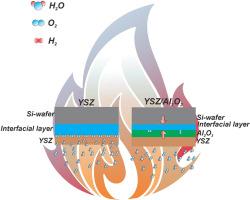Moisture-induced degradation of thermal barrier coatings on gas turbine blades in H2-enriched combustion environments
IF 8.3
2区 工程技术
Q1 CHEMISTRY, PHYSICAL
引用次数: 0
Abstract
Growing demands to mitigate the environmental impact of gas turbines have intensified research into low-emission fuels, with hydrogen-enriched blends emerging as promising candidates due to their efficiency and reduced carbon footprint. However, the elevated water vapor generated during hydrogen combustion accelerates degradation of hot-section components, particularly thermal barrier coatings (TBCs). This work evaluates the moisture resistance of multilayer α-Al2O3/YSZ (Yttria-Stabilized Zirconia) TBCs under hydrogen-rich combustion conditions. A custom-designed combustor equipped with a distributed combustion system was developed to replicate representative environments, and a dedicated sample holder enabled controlled thermal and moisture exposure. Coatings comprising YSZ and α-Al2O3/YSZ architectures were subjected to flame exposure for 10 and 15 min. Post-exposure characterization using Scanning Electron Microscopy (SEM) and X-Ray Diffraction (XRD) revealed progressive microcracking and spallation in YSZ with increasing duration, whereas degradation in multilayer systems was largely confined to the α-Al2O3 surface. No significant phase transformations were observed in either configuration.

富h2燃烧环境下燃气轮机叶片热障涂层的湿致降解
减轻燃气轮机对环境影响的需求日益增长,这加大了对低排放燃料的研究力度,富氢混合物因其效率高、碳足迹少而成为有希望的候选燃料。然而,氢燃烧过程中产生的升高的水蒸气加速了热截面部件的降解,特别是热障涂层(tbc)。研究了多层α-Al2O3/YSZ(钇稳定氧化锆)TBCs在富氢燃烧条件下的耐湿气性能。一个定制设计的燃烧器配备了一个分布式燃烧系统,以复制代表性的环境,和一个专用的样品夹实现控制热湿度暴露。含有YSZ和α-Al2O3/YSZ结构的涂层分别在火焰中暴露10和15分钟。利用扫描电镜(SEM)和x射线衍射(XRD)对暴露后的形貌进行表征,发现随着暴露时间的延长,YSZ的微裂纹和剥落逐渐发生,而多层体系的降解主要局限于α-Al2O3表面。在两种构型中均未观察到明显的相变。
本文章由计算机程序翻译,如有差异,请以英文原文为准。
求助全文
约1分钟内获得全文
求助全文
来源期刊

International Journal of Hydrogen Energy
工程技术-环境科学
CiteScore
13.50
自引率
25.00%
发文量
3502
审稿时长
60 days
期刊介绍:
The objective of the International Journal of Hydrogen Energy is to facilitate the exchange of new ideas, technological advancements, and research findings in the field of Hydrogen Energy among scientists and engineers worldwide. This journal showcases original research, both analytical and experimental, covering various aspects of Hydrogen Energy. These include production, storage, transmission, utilization, enabling technologies, environmental impact, economic considerations, and global perspectives on hydrogen and its carriers such as NH3, CH4, alcohols, etc.
The utilization aspect encompasses various methods such as thermochemical (combustion), photochemical, electrochemical (fuel cells), and nuclear conversion of hydrogen, hydrogen isotopes, and hydrogen carriers into thermal, mechanical, and electrical energies. The applications of these energies can be found in transportation (including aerospace), industrial, commercial, and residential sectors.
 求助内容:
求助内容: 应助结果提醒方式:
应助结果提醒方式:


